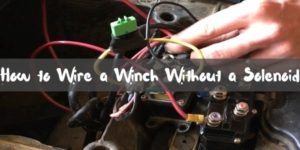Last Updated on June 20, 2021
We all agree that solenoids are important parts of running winches. After all, they prevent overheating and act as a switch, regulating the motor’s current to the winch.
But what if you doubt that the solenoid is working, because you get not just dirty gases, but overheating of the system? You will need to understand the basics of operating the winch without a solenoid.
Good for you; we already have a laid-down guide that is in simple, comprehensible steps. So, let’s get things underway in the process.
Quick Navigation
How to Run a Winch Without a Solenoid
Despite the fact that it is impractical to run the winch without a solenoid in a real winching plan, the process is helpful for your solenoid renovation. Besides, you probably ruled out that the problem was the solenoid, yet some other part between the motor and the winch is the issue.
Therefore, a few of your minutes on this article will equip you with the necessary knowledge to run the test.
You will need the following:
- Jumper cables
- spanner/ pliers
Step 1: Disconnect the Solenoid
Since your aim is to operate the winch without the solenoid, disconnect the solenoid. Usually, it lies in between the battery and the winch motor. Start with the positive cables, followed by the rest. Ensure that the process is gentle and free of pulling to prevent any damages.
Step 2: Ensure that the Cable is Spooling
First, look for the point of the winch where it is written “Disengage,” and press on it. The step will see the cable spooling through and through. Do not try to prevent the spooling at all.
Ensure that the cable is spooling in a tangle-free manner so that it will not be damaged in the process.
Step 3: Disconnect the Winch from the Battery
Usually, the winch is always connected to the battery, in case you need to use it at some point. You will have to disconnect it from the battery first, which will keep both you and the equipment safe. Remember the pair of pliers you were to tag along? You will need them at this point for safe disconnection.
Firstly, you will disengage the positive terminal from the battery, usually red in color. If the terminus does not present a color code, label it because leaving them disconnected could confuse confusion.
Disconnect the negative terminus, but you will have to leave the earthing one at this point.
Now, the points that you leave on the motor feature three labels, including F1, F2 and, A. these posts will be essential for our subsequent steps in the process.
Step 4: Time to Use Your Jumper Wire
You also brought a jumper wire with you, right? The jumper wire will act in place of the solenoid to prevent extreme heating from the circuit because it will essentially break it.
Put the jumper cable between point A and F1, and then connect it to the battery. At this point, you will need the help of the F2 post between the motor and the battery.
With this step completed, you are finally done with the first process. Finally, the motor can run in a single forward direction, which is a great success.
Put the reverse process into the test, remove the cable, and put it in a different post arrangement. It will be running between post F2 and A. then, the post labeled F1 acts as the link between the motor and the battery.
The second procedure will see the motor running in the reverse direction, which means that you can test the winch both ways.
Step 5: Allow the Winch to Run Without a Solenoid
At this point, you can switch on the winch, using a toggle switch, and let the engine run for a short time. If the dirty gases are still on the rise, it means that the solenoid has no problem at all. Therefore, you can go on checking the next part that could be the issue on the winch.
However, if overheating and the previous dirty gases persist, you will have to look into the solenoid. You can have it repaired, or even replace it if it is an old piece of equipment.
Points to Note
- If you are not sure about the solenoid connection, it will be wise to have a solenoid connection diagram. This way, you will neither mess with its disconnection nor the jumper wire connection.
- Ensure that you are in a safe open place when performing the solenoid experiment. As we mentioned, solenoids are your surest bet for overheating prevention. Being in the open air keeps you safe from any emergent occurrence.
Can You Winch a Car Without a Solenoid?
No, you can’t. Even if it is possible to run the winch without the solenoid, this is only intended for test purposes. However, it is not safe to winch a load, especially not a car, without a solenoid.
Hauling a car or a heavy load calls for extreme electric energy, which, if not regulated, will burst the winch motor. You will not even have tried it for a minute before you get the shock of your life.
How Do I Know If My Winch Solenoid Is Bad?
If your winch solenoid is bad, you will experience the impact of working without a solenoid. Worse still, the effects of a faulty solenoid. For instance, your winch will be overheating even when the solenoid is on, and dirty gases are constantly coming off the winch.
At this point, you will need to test the solenoid to confirm that it is really bad and even operate the winch without a solenoid. When you run a winch without a solenoid, and the challenges are no more, then you can tell that the solenoid is bad.
Then, with the solenoid test, you will confirm whether the solenoid can pass the battery’s charge. Overheating indicates that the solenoid could not be functional at all.
Final Words
As simple as four steps, and you finally have your winch that is working without the help of the solenoid. Nevertheless, remember to avoid having the winch run for too long. Remember that the solenoid is the only best way to prevent overheating. Thus, if you do not want to invest in yet a new motor, keep working without the solenoid.
We’re hearing from you. If you’ve any question about wiring a winch without a solenoid, then don’t hesitate to inform us. We’ve also listed some winch guides below that you might like to read.
- A detailed guide on the best winch for the money
- Offroad truck recovery winch buying guide
- What are the best portable electric winches
- Guide to using a winch without remote
- What are the best winch battery to buy
- Difference between winch contactor & solenoid


I’m Daniel Galbreath, founder of OffRoadersWorld.
I spend my spare time writing on this website, OffRoaders World. I share my thoughts and reviews on different types of gears, share tips sometimes. This website is specially created and regularly updated basically to help other folks like me when I started to solve the various problems they face, specially when they go off-roading.
